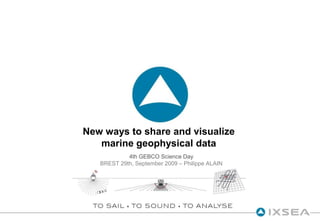GEBCO 09 - DELPH
- 1. New ways to share and visualizemarine geophysical data4th GEBCO Science DayBREST 29th, September 2009 â Philippe ALAIN
- 2. IntroductionA growing number of organizations, universities, port authorities, survey companies, etc. are looking for new tools to visualize and share marine geophysical data.While the interest of a final paper or digital report is still of great importance, the ability to compare and merge multiple data sources and dig into the data is now available to anyone.Most geophysical packages are use proprietary formats and dedicated viewers. It results in long conversion times to standard GIS formats.DELPH software is built on modern GIS standards, removing conversion bottlenecks and easing geophysical data sharing.
- 3. Side-Scan Sonar DataDELPH Sonar AcquisitionDELPH SonarINterpretation
- 4. Side-Scan Sonar Data FlowSide-Scan sonars commonly deliver digital raw data that is stored in industry standard XTF format.Signal processing and mosaicking lead to backscatter maps â mosaics - for use in GIS applications.
- 5. Side-Scan Sonar Data â Interpretation resultsProfile annotation and feature contouring in DELPH save synthetic information to KML or ShapeFile Layers.Benefits: Synthetic and Lightweight interpretation results
- 6. Side-Scan Sonar Data â Interpretation resultsPDF Printing drivers can be used to create documents at a desired size (A4, A3, A0) and at a desired resolution (300, 600 dpi) to share sonar data at an optimal resolution.Benefits: Interpreted profiles with sonar imagery can be shared in a lightweight standard format.
- 7. Side-Scan Sonar Data â TargetsSide-Scan Sonar targets are created in geoTIFF file format that can easily be used in any GIS or picture viewerHTML export can help to constitute a repository of contact informationXML, CSV, ASCII reports help data integration in third party systemsASCIIXMLHTMLCSV
- 8. Side-Scan Sonar Data â MosaicDELPH natively creates Side-Scan Sonar mosaics as a compilation of multiple geoTIFFtiles to reduce the volume of data due to uncovered areas.
- 9. Data tilingalso speeds the data access, allowing ÂŦ level of details Âŧ optimisations in common GIS systems.
- 10. Using data tilesavoids the limit in file size regardless of the format.
- 11. Mosaicscanalsobesaved to a single geoTIFF file whenneeded
- 12. All tilescanbeexported to the KMZ format (reprojection to WGS84, conversion to PNG tileswith no-data masking) to beshared and displayed in GoogleOcean.Side-Scan Sonar Data â Mosaichttp://delph.ixsea.com
- 13. Side-Scan Sonar Data â Mosaichttp://delph.ixsea.com
- 14. Side-Scan Sonar Data â Mosaichttp://delph.ixsea.com
- 15. Magnetometer DataDELPH MAG LOCATOR
- 17. Magnetometer Data - MapsMagnetic maps are natively created as a compilation of multiple geoTIFF tiles.
- 18. DELPH uses ESRI ArcGIS components to represent spatial data in a 3D environment including the magnetic map and the magnetic anomaly vector which one is a XYZ ShapeFile
- 19. Standard GIS formats can be used as background information (geoTIFF, ShapeFile, DXF).
- 20. Additional datasets can be added to the geographic view (sub-bottom interpretation, side-scan mosaics âĶ)Magnetometer Data - MapsMagneticmaps are nativelycreated as a compilation of multiple geoTIFF tiles.
- 21. DELPH uses ESRI ArcGIS components to represent spatial data in a 3D environmentincluding the magneticmap and the magneticanomalyvectorwhich one is a XYZ ShapeFile
- 22. Standard GIS formats canbeused as background information (geoTIFF, ShapeFile, DXF).
- 23. Additionaldatasetscanbeadded to the geographicview (sub-bottominterpretation, side-scan mosaics âĶ)Magnetometer Data - MapsMagnetic data is often difficult to interprete since it is not ÂŦ imagery ÂŧOther data types including sonar backscatter, bathymetry, sub-bottom information provide additional information to understand the observed anomalyes (topography, visible objects, wrecks, pipelines, cables, etc.)DELPH simplifies the way to achieve a magnetic map, provides 3D multi-sensor visualization tools but how to share that data to final customers how donât use geophysical software ?DELPH KMZ export capability fits this need by creating GoogleOcean layers including the magnetic map and navigation tracks.GoogleOcean transparency feature allows the overlay of the magnetic map and the side-scan sonat mosaic.
- 24. Magnetometer Data - Mapshttp://delph.ixsea.com
- 25. Magnetometer Data - Mapshttp://delph.ixsea.com
- 26. Sub-Bottom DataDELPH SEISMIC AcquisitionDELPH SEISMICINterpretation
- 27. Sub-Bottom Data FlowSub-Bottom data is commonly acquired and stored in industry standard SEGY format.Most interpretation reports include paper plots and formated text files of picked horizons.
- 28. Sub-Bottom Data - InterpretationInterpretation on vertical planes is difficult to understand in spaceAcoustic reflectors picked on the seismic profiles lead to XYT shapefilesCSV formatted text files can be used in modelling software and GIS databases
- 29. Sub-Bottom Data - InterpretationPDF Printing drivers can be used to create documents at a desired size (A4, A3, A0) and a desired resolution (300, 600 dpi) allowing to share interpreted seismic profiles at any resolution.Benefits:Interpreted profiles can be shared in a lightweight standard format.
- 30. Sub-Bottom Data - MapsDELPH Seismic creates geo-referenced vertical view of the sub-bottom profiles and models the picked horizons to build geoTIFF maps that can be exported to KMZ layers
- 31. To go further âĶData DisseminationSurveying huge areas with multiple sensors increases the data volume a lot. Data-centers and dynamic access to data through web-based protocols will become a standard tool.Sample Integration: SHADOWS mapping sonarFactory developments and integration allow web-based access to large scale high resolution sonar mapsQ.C. computerProcessing computerGeoTIFF MapLocal NetworkStorage computerRaw DataGigabit dedicated NetworkUser computerSonar Control / CommandVisualisationUser computerProcessing / Interpretation
- 32. ConclusionNative supporting standard fileformats not only optimizes thework-flow in geophysical mappingbut also offers new tools toshare/distribute data:Digital products become new deliverablesData visualization benefits of recentdevelopments with the globe applicationsIntegration of high resolution data (sonar, mag, etc.) with surface data (buildings, bridges, etc.) is now possibleInformation:delph@ixsea.comhttp://delph.ixsea.com
- 33. For more information: http://delph.ixsea.com

























